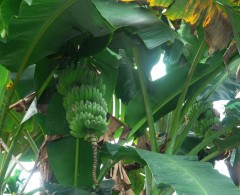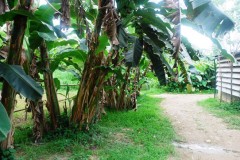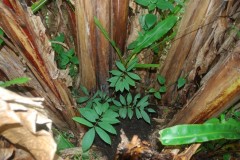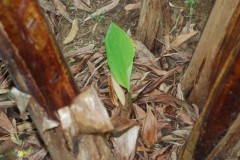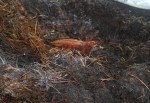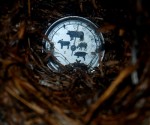Apr 26, 2010
Permaculture is Bananas
Banana plants (it's a giant herb) can make their own food, retain water, and in our farm continuously produce 20 to 40 kg bunches without significant input.
Banana plants at our farm. Producing fruits year after year in the same spot without replanting.
Nowadays farmers grow rows and rows of tissue-cultured clones. These require high fertiliser and fungicide inputs.
At our farm, the banana epitomises permanent agriculture. We use our human intelligence to plant them at the right place - they like moisture and organic material. They will form a clump - trim the clump to about 4 to 5 plants so that they will produce reasonable sized bunches
A banana clump serves as a heat absorber. They cool down the earth due to their ability to retain water and reduce radiation of heat to buildings due to their shady leaves.
The centre of the clump hosts myriad microbes and earthworms due to its dark and moist conditions rich in organic matter. They quickly break down fallen leaves, dead trunks, etc into humus and then release these nutrients back to the clump as food. We only need to occasionally supplement with some compost and some chopped dead trunks.
We plant tuba or derris elliptica in the centre. The clump provides all the nutrients that the derris require. We don't even need to water the derris.
Derris in the clump :).
We have found that gingers do well in the clumps too. Gingers love organic matter and moisture. We are now planting ginger in all the clumps in the farm as a cash crop.
This temu kunci is growing at a faster rate than others planted outside the clump.
We, humans, have a choice - clear the land, plant rows and rows of clones and hybrids, feed them with synthetic nitrogen-based fertilisers and spray them with fungicides and due to the low contribution margin for such crops, go for 'volume', ie clear up more land to generate this 'volume';
Or go the permaculture way - use nature intelligently and work with nature to produce food for us for generations. We may not be rich in the short term, but we will be around for a far longer time. Multiple this idea by 100,000 farms and the landscape of the Earth's future changes!
16:44 Posted in Permaculture | Permalink | Comments (4) | Tags: permaculture, bananas, raised beds, compost, derris elliiptica, temu kunci, boesenbergia rotunda
May 27, 2009
Carcasses - Compost 'em for Sustainability
The disposal of carcasses and animal wastes often pollutes the environment. In Malaysia, farms generally bury them or burn them.
At DQ, we compost them and return them to the soil as fertiliser and as soil amendment. We have innovated our own method of composting carcasses, after much trial and error, as follows:
Lay the carcasses and wastes in layers and between the layers, cover them with carbon material such as dried lallang, leaves, etc. We generally require the abdomen of all carcasses to be opened to prevent inadvertently creating anaerobic conditions from forming inside the carcasses which may result in the formation of toxins.
Lactobacillus is sprayed on the layers to speed up the heating process. Lactobacillus is a medium heat microbe and works well and fast at our ambient temperature of around 30 celcius. Within a day they will bring the temperature of the heap to 45 celcius for the thermophilics to take over.

With enough moisture and oxygen, actinomycetes will jump into action almost immediately breaking down the materials in the heap and giving the characterisitic "earth" smell to your compost at the end.
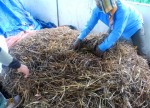
Cover up the pile neatly to retain the heat for the thermophilics to do their work thoroughly.
After a couple of days, the heat generated will be sufficient to cook an egg in a short while. Or to cook beef:
65 celcius - hot enough to cook beef.
The pile or heap should be turned a minimum of two times to ensure that as much of the material has gone through the heating process to destroy pathogens and even some toxins. At DQ this process will take 30 days.
After that, we introduce local composting earthworms to turn the compost to humus / vermicast. The composting earthworms ( eisenia fetida) works pretty fast, within 10 days they will have a few inches of vermicast for you to collect and use.
( Do not use imported earthworms as there are millions of microbes in the guts of earthworms and you may be introducing 'aliens' to our environment).

Beautiful black humus in just 40 days. The end result is a microbes-rich fertiliser suitable to be used as a soil fertiliser, as an amendment or as a foliar spray. We use this humus to build up sandy soil, as an anti-fungal, as fertiliser and generally to return to the soil what has been taken from it.
If you are already applying some other organic fertiliser, the addition of humus made the DQ way at a rate of 100kg per acre to acre and a half will see a 10 to 15 percent improvement in yields. And that's 10 to 15% straight to the bottom line as the inputs used are generally free!
17:23 Posted in Chickens | Permalink | Comments (5) | Tags: compost, carcasses, sustainable agriculture, organic farming








